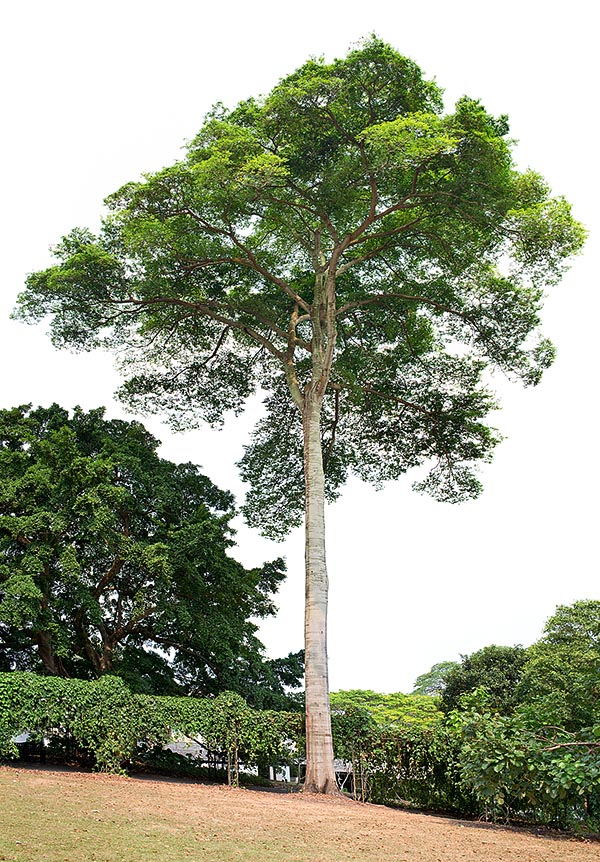Family : Fabaceae

Text © Pietro Puccio

English translation by Mario Beltramini

Hymenaea courbaril is a Central America tree reaching 40 m of height with more than 1 m broad trunk. Aromatic resin called copal for varnishes and incense. Big legumes. Alimentary and medicinal uses © Giuseppe Mazza
The name of the genus comes from the Latin “himenaeus” = marriage, with reference to the leaves formed by two leaflets; the specific name is one of those used locally.
Common names: amami-gum, Brazilian copal, South American-locust, stinking breath, West Indian-locust (English); caroubier de la Guyane, copa de Brésil, courbaril, gomme animée (French); castanheiro-de-bugre, cuapinol, farinheira, guapinole, jatai, jatobá, jitai, jutai, jutaí-açu, jutaí-bravo, jutaí-grande (Portuguese Brazil); algaborillo, algarrobo, copal, cupinol, curbaril, guapinol, palo de sangre, paquio (Spanish); Heuschreckenbaum (German).
The Hymenaea courbaril L. (1753) is a usually 30-40 m tall tree with erect trunk, of up to more than 1 m of diameter, with smooth and greyish bark and tabular roots (roots similar to buttresses contributing to the support of the tree), in the oldest specimens, up to 1 m tall. The leaves, on a 1,5-2 cm long, are alternate and formed by two oblong subsessile leaflets with entire margin and obtuse or pointed apex, asymmetric with respect to the central rib, coriaceous, of glossy dark green colour above, paler below, 5-10 cm long and 3-5 broad. Terminal panicle inflorescences, 10-15 cm long, bearing whitish bisessual flowers, at times suffused of purple, of about 3,5 cm of diameter. Calyx formed by 4 oblong-ovate concave sepals, 1-2 cm long, tomentose, corolla with 5 unequal elliptic petals, 1,5-2 cm long petiole and 1 cm broad, and 10 white stamina, 2,5-3,5 cm long. The fruits are indehiscent (that do not open when ripe) woody legumes with oval section, 4-16 cm long, 2-6 cm broad, and 2-3 cm thick, of reddish brown colour. The fruits contain 1-5 slightly compresses ellipsoid seeds, 2-3 cm long and 1,8-2,5 cm broad, of glossy brown red colour, immersed in whitish powdery pulp, edible but of rather unpleasant smell.
It reproduces by seed, previously scarified and immersed in water, frequently changed, for three days, in sandy loam maintained humid at the temperature of 26-28 °C, with germination times of 2-4 weeks and first blooming when 8-12 years old.
Species cultivable in the tropical and humid subtropical climate zones, where requires an exposition preferably in full sun, adapting to different types of soil, also poor, and bearing water stagnations as well as drought periods.

Close-up of fruits, seeds and resin. It forms on the bark scars and underground (grey blocks). A prized edible powder is got from the legumes © Charles Brewer Carias
It is often utilized in the reforestation programmes of degraded areas, whilst the employment as ornamental plant is limited for the heavy legumes that rotting on the ground emit an unpleasant odour.
Synonyms: Hymenaea resinifera Salisb. (1796); Hymenaea animifera Stokes (1812); Hymenaea candolleana Kunth (1823); Hymenaea retusa Hayne (1830); Hymenaea courbaril var. obtusifolia Ducke (1925); Hymenaea multiflora Kleinhoonte (1926); Inga megacarpa M.E.Jones (1929).
→ To appreciate the biodiversity within the family of FABACEAE please click here.
